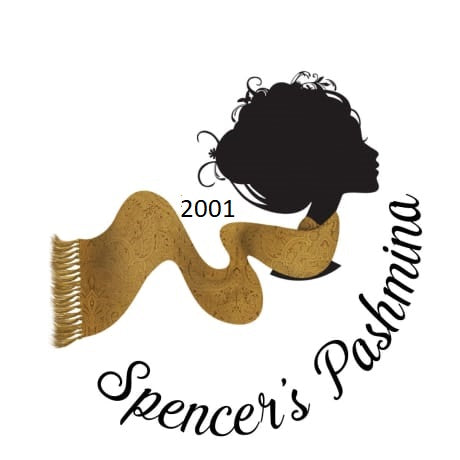What is Pashmina?
Origin
The word, ‘Pashmina’ has its origin in the Persian word ‘Pashm’ which means wool. However, over many centuries, pashmina wool has come to be known as a special kind of wool which comes from the hair of the goats grazing in the high altitudes of either side of the Himalayas, India and Nepal. The goats are called Changthangi goats. They shed their winter coat every spring. Approximately 4 to 8 ounces of pashmina hair are shed by each goat. It takes hair of two to three goats to make one good quality pashmina shawl or stole. These hair are handspun and turned into pashmina wool. This pashmina wool is woven by the artisans on handlooms to produce pashmina fabric and then pashmina scarf, stole, wrap, shawl or throw. The pashminas from Kashmir are also known as Cashmere Pashmina (the changed name of Kashmir, a state of the Indian subcontinent). We find the words ‘Cashmere’ and ‘Pashmina’ being used as a substitute of each other. The two words are also used together to express the pashmina produced in Kashmir. The word ‘Pashmina’ refers to both pashmina wool as well as pashmina shawl and wrap. Pashminas are thin and soft to touch, light in weight, yet warmer than the ordinary woolen ones or the ones made from acrylic or viscose.
Written material about pashmina dates back to the period between 3rd century BC and the 11th century AD. Zayn-ul-Abidin, the 15th century ruler of Kashmir, is known to be the founder of the pashmina wool industry. He patronized weavers from Central Asia to promote pashmina trade.
Craze in Europe
Napoleon may have started the pashmina craze in Europe when he presented a pashmina shawl to his wife, Josephine. Ladies of the 18th century court in France and St. Petersburg were enchanted by the regal feel and warmth of these wraps. Pashmina is an indispensable women’s fashion accessory. It remains an essential part of a fashionable wardrobe, attesting to the durability and appeal of this classic accessory.
Mongolia
The goats bearing pashmina hair are commercially reared in the Himalayas as well as now in Gobi Desert (in Mongolia). The weather conditions in Mongolia are similar to those of the Himalayan region, and are quite suitable for the goats to grow pashmina hair. Owing to availability of vast open grazing grounds, production of pashmina in Mongolia costs less than the Himalayas. The quality of pashmina wool obtained from the Himalayan goats is better than the one obtained from the Mongolian goats.
Is Pashmina Legal in the US?
Yes, import, sale and purchase of pashmina is legal in the US. The U.S. Federal Trade Commission (FTC) has strict labeling requirements. This is to ensure that consumers are not misled about the quality and origin of the fabric. Under these guidelines, any product labeled as "pashmina" must contain at least 70% cashmere wool from the Changthangi goats, which is the only animal used to produce genuine pashmina.
Categories and Sizes
Pashminas come in two categories keeping in mind the composition of fiber. These are Pure Pashmina and Silk Pashmina. The former has the fiber composition of close to 100% pure pashmina wool. The latter has the fiber composition of 70 to 80% pure pashmina and 30 to 20% silk. The sizes of pashmina are:
- Scarf: 12”x 60”
- Scarf: Large. 18”x 72”
- Stole: 22”x 80”
- Wrap: 28”x 80”
- Shawl: 36”x 80” and 40”x 80”
- Throw: 50”x 100”
Shahtoosh ‘Pashmina’
The competitors and others, with their vested interests, have rumored that pashmina is banned. They contend that pashmina is produced by killing the high altitude goats. It is a false propaganda. As stated earlier, pashmina is produced from the hair shed seasonally by the goats. It is Shahtoosh which is produced by killing the goats to use their inner skin. Shahtoosh is banned worldwide as it is produced by being inhuman to the animals and also for fear of extinction of the species. Despite this ban, Shahtoosh continues to be traded under the table. It is used by some of the rich ladies as a status symbol. Price of Shahtoosh is many times more than the price of pashmina. Shahtoosh is very thin, extra light in weight, yet very warm, even warmer than pashmina.
Fake or Faux Pashmina
Owing to ever increasing demand of pashmina and not everyone knowing how to judge the quality, quite a few imitations have come up in the market. Acrylic and viscose pashmina are two of the most common imitations. However, pashmina lovers are good at distinguishing between the genuine and the fake or faux pashmina. There are a number of ways to make this distinction manually on the spot.
Pashmina Uses
Pashmina is one of the few women’s fashion accessories which has always remained in vogue and will continue to be so. Besides its personal use on both formal and informal occasions, it serves as a good gift or a souvenir. Brides and bridesmaids take pride in wearing it as wedding pashmina.
